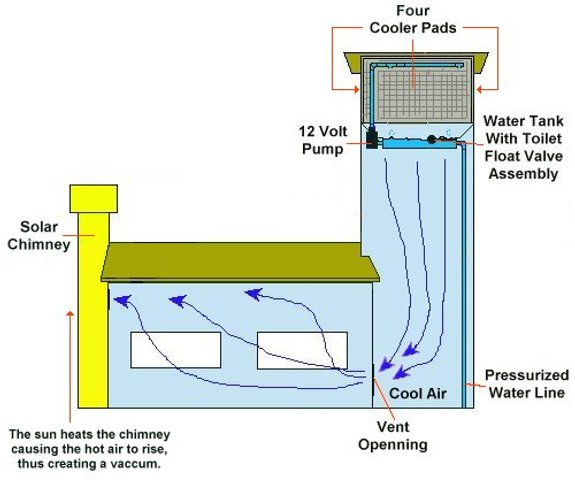
Another Do it yourself cooling option

In searching for more low
budget do it yourself cooling options I came upon this cooling
tower design.
It seems like one of the more
expensive solutions out there, but might end up saving money in the
long run. The tower should be at least 6 feet square, 20 to 30 feet
tall with as much insulation as you can muster.
I wonder if this concept
could be scaled down for just one room instead of an entire house?
Image credit goes to the thefarm.org which has a well written article
on this method of sustainable cooling. They've also got a good section
on
permaculture in Tennessee.
Want more in-depth information? Browse through our books.
Or explore more posts by date or by subject.
About us: Anna Hess and Mark Hamilton spent over a decade living self-sufficiently in the mountains of Virginia before moving north to start over from scratch in the foothills of Ohio. They've experimented with permaculture, no-till gardening, trailersteading, home-based microbusinesses and much more, writing about their adventures in both blogs and books.
Want to be notified when new comments are posted on this page? Click on the RSS button after you add a comment to subscribe to the comment feed, or simply check the box beside "email replies to me" while writing your comment.

Look into the design of the old North African Souk architecture. My last house was designed on the principles they employed... opening sky lights, casement windows able to catch a tiny breeze from any direction, open air flow... and we found that we only wanted AC when we messed it up by adding a 2nd floor with poor circulation and no tree cover.
It's way cheaper, and prettier, than a solar chimney.
Very good point, Zimmy. I think Roland's idea (if it was his) from a few weeks back about using water to cool air in a separate chamber so that it decreases humidity would be a very good tweak to this design.
April --- we'll have to look into that! I also was recently reading about a whole house fan --- intriguing idea. Of course, if we're going to do anything pricey, Mark wants to just build a hobbit hole in the side of the hill and use the coolness of the earth, but that plan is a few years off.
Daddy --- my understanding is that whole house fans are more than that. The ones I've read about exchange all of the air in the house with the outside air in just a few minutes. So, you could turn it on around dark, and turn it off half an hour later for a house completely cooled to exterior temperatures.
April --- Loud isn't really a problem --- Mark loves fans and turns them on at night to sleep by even when he doesn't need them. I'm glad to hear it works so well for you! I just ran across the concept recently, and it sounds wonderful.
Evaporating water takes a lot of energy (2257 kJ·kg⁻¹), so it is a quite efficient way to cool stuff. But unless you are in a very dry climate I would rather use a cooling tower to cool water that is then used to cool air via a heat exchanger. Unless you're fond of a wet indoor climate and growing mold in your living room, that is.
A solar chimney with a geothemal heat exchanger might work equally well in your case. Conceptually, the solar chimney in this case is just a "ventilator", but without electricity or moving parts. Quite appealing from an engineering point of view, because of its simplicity and the fact that it uses the sun to get rid of unwanted heat.
An related technology that you might find interesting is a solar updraft tower for generating electricity. A 50 kW max. power prototype was operated in Spain for about 8 years.
If you ever think about building an underground house, go and talk to an architect and/or a building engineer, for both structural integrity and heat flow management reasons! A layer of earth is quite heavy, especially when wet. In a relatively temperate environment like yours your house will probably require quite a lot of insulation and waterproofing (next to the earth walls) to prevent it from getting too cold and wet. See the "potential problems" section in the earth sheltering article.
A passive solar building design might also be an alternative. The linked article touches on the factors involved. It's not really difficult IMO, but it does require some physics/engineering background knowledge.
Anna, how long a whole house fan takes to cool a house depends to a large degree on how big the thermal mass of the house is and how well the walls give off heat.
To use an equivalent example of emptying a tank of water through a hole in the bottom; the larger the tank (thermal mass) the longer it takes to empty. The smaller the size of the hole (better isolation of the walls) the longer it takes. Of course the opposites also apply.
We did retrofit our trailer for passive solar heating, and our wall of south-facing windows gives us quite a bit of winter heat. I think we should probably extend the overhang just a tad, but we only get unwanted sun in those windows for a couple of weeks per year.
On the other hand, we have big windows on the west side of the trailer which are a pain in the summer. We need to get our act together and plant something there to shade them, or just make some kind of blinds to block the sun when it's low in the sky.